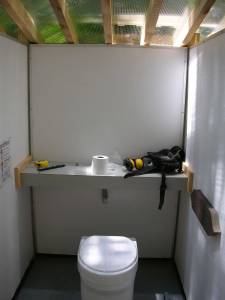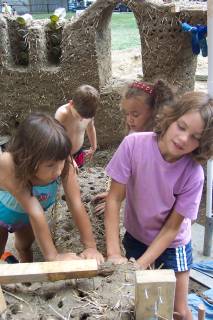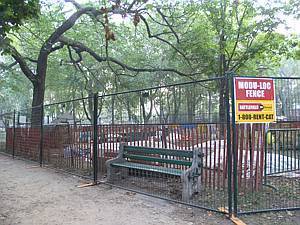Comments?
For the basics, see
- Website & Privacy Policies
- How To Get Involved
- The Role of the Park
Search options:
Department Site Map
Custodians:
Quick Page Table of Contents
Scanning...
By-Law Issues
posted September 6, 2006
REGULATION BLUES
 But the project has gotten a bit bogged down in the zealous application of rules by the City, such as this fence. Photo by Joe Adelaars. |
In the past few years there has been a new stage in the life of the park – the stage of testing whether the things that work well at the park should be banned because they might not conform to regulations or bylaws.
The zamboni crisis at the rink in 2004 was the beginning. That winter, multipurpose use of the rink house was briefly declared a health and safety infraction.
Last June, 2005, a playground user expressed great unhappiness about the possible illegality of building the cob courtyard, but by then there were too many people engaged in the project to bring it to a halt.
In July 2005 there was an anonymous complaint about people making their own pizzas at the wood oven, resulting in an order for staff to make all pizzas inside the building and rush them out to the oven. That order was quickly found to be unnecessary and rescinded.
In August 2005 there was an anonymous complaint about the farmers’ vehicles being parked at the market, but after a by-law officer told all the farmers that he would write them each $105 tickets if they returned the following week, an official permit was created. The farmers were able to continue bringing their food as before.
In November 2005 there was a large meeting at St.Mary’s High School to address the absence of a formal advisory council at the park, but the meeting participants were able to convey their confidence in a park with good staff but without a formal community meeting structure. [see results].
In February 2006 a serious standoff developed between City rinks zamboni drivers and on-site staff/rink friends, relating to our local practice of cleaning the ice one rink at a time and letting skaters continue to skate on the other rink. That issue – presented as a health-and-safety issue for the zamboni drivers – will hopefully be solved this year with the long-awaited construction of a little external paved path that allows the zamboni to travel between our two rinks without using the internal gate, therefore not requiring a guard at the gate.
In July-August 2006, complaints to the highest levels of City management, by three neighbourhood activists, led to repeated stop-work periods for the community-built addition of a composting toilet with a sculptural cob-surround, near the playground area. The worry about possible regulatory infractions made Parks management erect a six-foot-high fence to keep kids away from this project completely. A public meeting turned up no complainants willing to speak to the meeting, but a lot of ideas for how to make the project work. Parks management listened, and added input of their own, and the next day cob master-builder Georgie Donais found out that the hurdles had been crossed and the project could go ahead as planned.
This neighborhood is full of musicians: does anyone feel inspired to write a song for the park, called the “Regulation Blues”? It could have broad appeal beyond the park too, maybe become as big a hit as “Little Boxes” was in its day.
posted September 6, 2006
EDITORIAL: DAVID AND GOLIATH
(1) DAVID:
The small fellow in this fable is Georgie Donais. Last year she asked the Parks staff if they might bring in some sand, gravel, later a plumber and an electrician. She went to a local construction company and begged some clay, bought some tarps, and asked park users if they’d like to build a very old-style wall around the public health sinks that were needed for the summer food cart.
It turned out that lots of people, little and big, wanted to learn how to build using the ancient adobe method called “cob.” As the wall rose, little by little, built by so many hands of so many different sizes, the wall became a story magnet too. It seems that there’s hardly any culture that doesn’t have such buildings. People brought their photo albums from home, showing buildings in Yemen that are seven hundred years old and still inhabited, round adobe buildings in North Africa, thick-walled cob houses with thatched roofs in English villages. What a lot of joyful community talk and action! Georgie’s dad was a carpenter, and she admired his craft, but she wanted a form of building that was quiet enough for talking (not all that loud hammering). She was right. The wall went up one cob at a time, conversations led to friendships – and respect and admiration grew, day by day, for those people all over the world who developed this way of building. Georgie shaped and directed all this activity for free, and people freely came and went between the playground and the wall. Building was part of a day at the park.
At the end of September the “cob party” for people who helped was huge, and the cob courtyard has become a familiar, loved (and useful) landmark in the park.

National Park composting toilet
People kept telling Georgie that one small thing was still missing: a toilet in the playground. Parents and caregivers have asked, every year, for a nearby toilet ever since the current playground went in (in the eighties). But a plumbed toilet would cost $100,000 or more and there is no such money allocated for this park.
A composting toilet, on the other hand, would be much cheaper, and it could be a little (pilot-project) step to getting a part of the park off the sewage system that pollutes our lake.
Georgie researched the newer composting toilets at national parks, which are low-maintenance, non-smelly, and very efficient. An anonymous donour – inspired by last summer’s cob wall – said he would buy one for the park ($9000). Georgie applied for funding to create a community-built shelter for the toilet, and the Toronto Arts Council gave her $10,000 (on the strength of last year’s cob wall achievement). The Toronto Parks and Trees Foundation gave her another $2000 for materials and for the living roof (like the living roof on the end of the cob wall, full of flowers and native grasses). Georgie put the word out, and by the beginning of June, work was ready to begin.
(2) GOLIATH:

kids at last year's cob project
That’s Big Bureaucracy, in this fable. The composting toilet Georgie bought was the same as the one that’s been used for at least seven years in many national parks in Ontario and across Canada. The Class one composting toilet and its tiny surround are exempt from building permit requirements. But because this community art project has some attributes in common with a conventional construction site, the situation becomes muddied. The Goliath of bureaucracy paints reality in big, bold strokes: any building site is a safety hazard, whether it’s the new ROM or a little cob housing built around a single playground toilet. At construction sites, unless there’s a big fence to keep them out, people can break their necks, or be killed plunging down four-story holes. They can lose eyes and limbs. If a provincial inspector comes and finds a parent helping a kid apply clay to shape a little wall, and one or both of them are not wearing regulation steel-toed boots, the Park supervisor could be personally fined $15,000, or $50,000, under the Health and Safety Act, and he’d have to re-mortgage his house.
And then there are the environmental hazards. Just because the toilet is a state-of-the-art model used in national parks doesn’t mean the urban Goliath accepts it. An engineer is necessary to re-certify its design (at a price of more than half the toilet). And perhaps there needs to be an environmental assessment: what if this little seasonal toilet would spread pollution? What if the kids’ little bums were to contaminate the ground so widely that the poison would leach into the wading pool? What if a composting toilet poisoned the groundwater for the neighbouring houses? Will the City’s insurance cover that? (Eeeek!)
“David and Goliath” is a fable. If the fable is true, the good sense of the community might be the pebble that knocks Goliath out of the way of this little composting toilet. We’ll see how the story unfolds, at the September 12 community meeting. The nicest outcome would be if the “Davids” of the bureaucracy (those exist too) and the “Davids” of the community could work together to support the gifts that Georgie brings to the park. Then next year it would be safe to step near the playground trees again (i.e., the current frequently-used “toilets”), and parents and caregivers could relax when their little ones say, for the third time in an hour: “Daddy, I need to pee!”
Jutta Mason




 Printer friendly version
Printer friendly version

